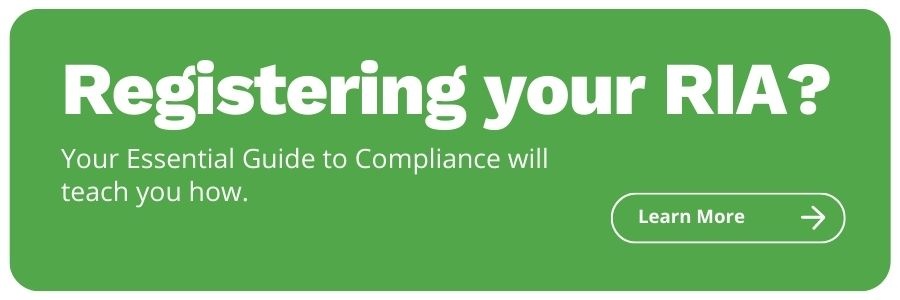Avoiding Common Regulatory Filing Deficiencies for Your RIA
Share this
In Alice In Wonderland, Lewis Carroll wrote: “‘The time has come,’ the walrus said, ‘to talk of many things: Of shoes and ships - and sealing wax… and updating your ADV!’” Ok, maybe that isn’t the exact quote, but let’s dig in!
After countless hours of drafting, editing, and revising your regulatory documents to meet the standards of your state or SEC, you realize that something has changed -- maybe you need to revise your fees or add an additional business location. Maybe you’ve taken on a new outside business activity. It may seem daunting to update all of the required documents that you’ve finally gotten approved, but have no fear! ADV amendments are a regular part of operating a growing and changing firm, and with a bit of knowledge and familiarity with the process, most common deficiencies can be avoided.
(Note: The information provided in this article is based on the regulatory documents at the time of writing. Subsequent changes to the documents by FINRA or other regulatory agencies may affect the accuracy of the instructions or the locations of references provided within the documents.)
Ch-ch-ch-ch-changes! First, let’s talk about when to update your ADV. There are two types of changes that will be reflected in your filings: material changes and non-material changes.
In general, some examples of material changes may include, but are not limited to:
-
A change of address/location or contact information (e.g., phone number, email)
-
New owners of the investment adviser entity
-
A significant change in services offered
-
New potential conflicts of interest
-
A new fee schedule
-
Changes in disciplinary history
-
Changes in the custodian or broker used
-
Changes in licensing status with the SEC or state(s)
Material changes require your regulatory filings to be updated “promptly” which is commonly defined as being not later than 30 calendar days after learning of the facts or circumstances giving rise to the amendment or update. Material changes should be listed in the ADV Part 2A in Item 2 with the item number of the changed information and a brief description of the change. Item 2 must also include the date of the last update to the ADV.
Non-material changes include changes such as variations in client numbers or AUM. Non-material changes should be updated at least annually during your ADV annual update.
In addition to the updates to the ADV, investment adviser representatives (IARs) are also required to keep their Form U4 filings up-to-date.
The following are some examples of changes that likely will result in the need for an investment adviser to update the investment adviser representative’s Form U4:
-
A name change
-
A change in business location or personal residence
-
Changes to employment or outside business activities
-
Certain criminal, regulatory, civil judicial, customer complaint/arbitration/civil litigation, and financial disclosure events
So, what are some common updates that most advisers will eventually need to make?
1) Address and Contact Information Changes
Let’s start by looking at changes to the adviser’s place of business and other contact information. Many new advisers choose to use their home as their primary place of business while launching their firms, but we frequently see advisers adding additional locations or changing their primary location to a commercial address after getting their firms off the ground.
To clarify what we mean by “place of business” one of the cleanest definitions comes from the Ohio Administrative Code 1301:6-3-01(G), which states: “Ohio law defines “place of business” to include two categories of locations. First is an office at which an investment adviser or investment adviser representative regularly provides investment advisory services, solicits, meets with, or otherwise communicates with clients. Second is any other location that is held out to the general public as a location at which an investment adviser or investment adviser representative provides investment advisory services, solicits, meets with, or otherwise communicates with clients.”
One question that arises from the above definition is: “What does ‘held out’ to the public actually mean?” A location is considered “held out” to the public, for example when, publishing information in a professional directory or a telephone listing, or distributing advertisements, business cards, stationery, or similar communications that identify the location as one at which the investment adviser or investment adviser representative is or will be able to meet or communicate with clients.
However, an investment adviser representative who sends a letter to certain existing clients indicating, for example, that he or she will be in their area and available for a meeting would not have held out the location of the proposed meeting to the general public for purposes of the definition. Similarly, an investment adviser representative that communicates to a defined group under the terms of an advisory contract the location at which he or she will be available would not be holding himself or herself out to the general public. Further, in the case of a national organization that engages an adviser to provide advisory services to its members, an adviser representative who communicates its availability at a certain location to the members (even though those individuals may not be clients) would not be holding himself or herself out to the general public. The definition encompasses permanent and temporary offices as well as other locations at which advisory services are provided, such as a hotel or auditorium.
Whether an investment adviser representative will be subject to the qualification requirements of a state in which the hotel or auditorium is located will turn on whether, for example, an investment adviser representative conducts advisory business there. [From the SEC Release IA-1633m [1997 Transfer Binder] Fed. Sec. L. Rep. (CCH) ¶ 85,940 (May 15, 1997)]
When in doubt whether or not an additional location needs to be disclosed, we’d recommend reaching out to your state regulator contact to discuss the specifics of your situation. Keep in mind, that in addition to other locations where advisory activities are being conducted, any locations where the firm’s books and records, other than the primary business location, must be included in the ADV Part 1, Item 1.L and further described in Section 1.L of Schedule D.
Now that we’ve addressed the definition of your address (see what I did there?), here are some areas to check for consistency as you make your changes:
-
Starting with your ADV Part 2A and 2B, the firm’s address is required on both the Part 2A and the Part 2B cover pages. Since this is likely the most visible address from a client perspective, making sure that the cover page address accurately reflects your primary place of business is key.
-
Phone number changes frequently result from a location change and should be updated not only on the Part 2 cover page but also throughout the remainder of the document.
Using the “search and replace” (or equivalent) feature in your preferred word processing software is a great way to avoid missing needed updates. Don’t forget to check your client agreements (especially important), privacy policy, compliance manual, and other firm documents for address or contact information discrepancies. While these documents do not need to be submitted directly to the state for review of the changes, they are frequently observed to be out-of-date during firm examinations.
Next, if the primary place of business is changing, the ADV Part 1, Item 1.F (1) will need to be amended. Additional changes to the hours of operation (2), the firm’s phone number (3), and fax number (4) will also be updated in this section. You will also want to ensure that the address and contact information for your firm’s CCO, ADV Part 1, Item 1.J (1) is revised if needed. If your firm is organized as a Sole Proprietorship, you will need to update the ADV Part 1, Item 1.H, if your firm address is no longer the same as your residence.
Pro CCO tip: Make sure to check or uncheck the “private residence” box under Item 1.F or 1.G! While the address on the ADV Part 2 cover page will be publically visible, addresses marked as “private residence” on the Part 1 will not be publicly disclosed on the IAPD website.
Once the amended ADV Part 1 has been filed to update the primary place of business, the Office of Employment address in Section 1 of the Form U4 will be automatically updated, but if the firm’s new address requires a change of the firm’s city or state, the address provided in the Form U4, Item 12 employment history should be updated to match. Keep in mind, if your firm address is changing due to a change in your primary residence, your Form U4 residential history in Section 11 will need to be updated, too!
Please be aware that changing the CCO’s email address (as Super Account Administrator for the firm) will require additional verification steps. FINRA can provide the Update/Replace SAA Form to update the name or email address of the current SAA. This form must be requested by an Authorized Signatory of your organization. An Authorized Signatory can contact the FINRA Gateway Call Center to request the Update/Replace SAA Form. The FINRA Entitlement Group confirms the identity of the requester and pre-populates the form with a unique identifier specific to the request. FINRA sends the form only to an Authorized Signatory at the firm, using the individual’s contact information on file. The form can be submitted electronically via DocuSign or a downloadable PDF submitted via email, fax or mail. When the completed form is returned to FINRA, the pre-populated information on the form must match the unique identifier that FINRA provided. FINRA assigns a unique identifier to each update/replace request and therefore, a firm must request another Update/Replace SAA Form for a subsequent request.
If you are not changing the firm’s primary place of business, but instead, are adding additional locations, the additional locations may be included on the cover page of the ADV Part 2A. ADV Part 1, Item 1.F (5) will need to be amended specifically to reflect how many additional locations, other than your principal office and place of business, at which you conduct investment advisory business as of the end of your most recently completed fiscal year.
In Section 1.F. of Schedule D, you will list any office, other than your principal office and place of business, at which you conduct investment advisory business. If you are applying for registration, or are registered, with one or more state securities authorities, you must list all of your offices in the state or states to which you are applying for registration or with whom you are registered. If you are applying for SEC registration, if you are registered only with the SEC, or if you are reporting to the SEC as an exempt reporting adviser, list the largest twenty-five offices in terms of numbers of employees as of the end of your most recently completed fiscal year.
Finally, the firm’s mailing address (if the firm is receiving mail at a location other than the primary place of business) can be updated on the ADV Part 1, Item 1.G.
2) Outside Business Activities
Another very common change for advisers is adding new outside business activities (OBAs) for the firm’s IARs. New opportunities are wonderful! But how do you correctly disclose the change?
To begin, let’s clarify which activities of an IAR meet the definition of an OBA. FINRA rule 3270 states: “No registered person may be an employee, independent contractor, sole proprietor, officer, director or partner of another person, or be compensated, or have the reasonable expectation of compensation, from any other person as a result of any business activity outside the scope of the relationship with his or her member firm, unless he or she has provided prior written notice to the member, in such form as specified by the member.”
To restate the rule, OBAs can be any activities that a Supervised Person may be engaged in outside of their employment with the firm. These activities may include, but are not limited to service as an officer, director, partner, employee, consultant or independent contractor with any for-profit or non-profit organization.
A person may be engaged in an outside business activity if they are:
-
employed by any other person or entity
-
receiving compensation from any other person or entity
-
serving as an officer, director, or partner of another entity
-
serving in a fiduciary capacity (e.g., trustee, executor or power of attorney) for someone other than a family member.
One primary distinction being that services provided by an adviser for which the firm is compensated are not outside business activities. Services provided by the firm must be disclosed in the ADV as activities of the firm, not OBAs of an IAR. Common for-profit OBAs can range from driving for a rideshare company on weekends, all the way up to running a CPA firm or providing paraplanning services.
How to properly disclose an OBA can vary based on the nature of the activity.
Investment-related OBAs or OBAs involving financial services will often require more information to be disclosed than non-industry OBAs. For example: for an IAR with a part-time job as a personal fitness trainer, the activity would be briefly described in the ADV Part 2A, Item 19 and the ADV Part 2B, Item 4. An appropriate description would include the name of the other business, the IAR’s relationship to the other business or position title, and the approximate percentage of the IAR’s time the activity requires or the approximate number of hours per week the IAR spends on the activity.
For activities requiring a significant portion of the IAR’s time, many regulators require the IAR to include a description of their availability to clients of the firm during securities trading hours. The same information should be included in Item 2.G(2) of the ADV Part 1B. For the Form U4, Section 13 should be marked “yes” and in the accompanying text box, you will provide the following details: the name of the other business, whether the business is investment-related, the address of the other business, the nature of the other business, your position, title, or relationship with the other business, the start date of your relationship, the approximate number of hours/month you devote to the other business, the number of hours you devote to the other business during securities trading hours, and a brief description of your duties relating to the other business. Don’t forget to update your business experience in the ADV Part 2A, Item 19 and ADV Part 2B, Item 2 and your employment history in the Form U4, Item 12!
In addition to the ADV Part 2 and Form U4 changes listed above, when disclosing a financial industry-related or industry-adjacent OBA for related persons of the firm, specific businesses will also require an update to the ADV Part 1, Item 7. These businesses include:
-
Broker-dealer, municipal securities dealer, or government securities broker or dealer (registered or unregistered)
-
Other investment adviser (including financial planners, for which the IAR is compensated by an individual or entity other than the firm)
-
Registered municipal advisor
-
Registered security-based swap dealer
-
Major security based swap participant
-
Commodity pool operator or commodity trading advisor (whether registered or exempt from registration)
-
Futures commission merchant
-
Banking or thrift institution
-
Trust company
-
Accountant or accounting firm
-
Lawyer or law firm
-
Insurance company or agency
-
Pension consultant
-
Real estate broker or dealer
-
Sponsor or syndicator of limited partnerships (or equivalent), excluding pooled investment vehicles
-
Sponsor, general partner, managing member (or equivalent) of pooled investment vehicles
For each related person, you will also complete Section 7.A. of Schedule D. You do not need to complete Section 7.A. of Schedule D for any related person if: (1) you have no business dealings with the related person in connection with advisory services you provide to your clients; (2) you do not conduct shared operations with the related person; (3) you do not refer clients or business to the related person, and the related person does not refer prospective clients or business to you; (4) you do not share supervised persons or premises with the related person; and (5) you have no reason to believe that your relationship with the related person otherwise creates a conflict of interest with your clients.
In the ADV Part 1B, 2.G(1) you will need to select the applicable boxes for any advisory affiliate or any management person actively engaged in business as a(n):
-
Tax Preparer
-
Issuer of securities
-
Sponsor or syndicator of limited partnerships (or equivalent), excluding pooled investment vehicles
-
Sponsor, general partner, managing member (or equivalent) of pooled investment vehicles
-
Real estate adviser
Any OBA that falls under the specific businesses listed in the ADV Part 1, Item 7 or the ADV Part 1B, 2.G(1) will likely also require a brief disclosure in the ADV Part 2A, Item 10. The Item 10 information should include an explanation of any conflicts of interest between the firm and the IAR’s OBA, to include the presence of any solicitation arrangements or other relationships between the two entities.
3) Changes to Fees and Services
Lastly, let’s touch on what is probably the most common reason for amending the firm’s ADV: changes to the firm’s services or fees.
Building off of our discussion on OBAs above, the firm’s services should include all services provided by the firm for which the firm receives compensation. Most new RIAs offer advisory services including options such as: investment management, pension planning, and/or financial planning. Within those broad offerings, additional specific services, i.e., hourly financial planning, educational seminars or speaking engagements, or investment management through a TAMP or third-party manager are possible.
Some firms offer additional non-advisory services, which may include tax preparation, bookkeeping, or business coaching. When it comes to the firm’s services, the bottom line is this: if the firm receives compensation for the service, the service must be disclosed as a service of the firm, described in a clear, concise manner, and must have an accompanying fee schedule or fee calculation.
Beginning with the ADV Part 2A, each service of the firm should be listed and described in Item 4. Each service should have a clear title/heading and include in the description an explanation of what is included with the service and any deliverables the client will receive.
In Item 5 of the Part 2A, the fee schedule or method of calculation for the service’s fees should be disclosed under a clear title/heading that matches the title or heading of the service from Item 4. In addition to the calculation, fee descriptions should include:
-
The applicable billing period (one-time, monthly, quarterly, etc.)
-
Payment terms (due in advance, arrears, 50% upfront, etc.)
-
Whether or not the fee is negotiable, payment options (check, EFT, direct withdrawal from a client account, etc.)
-
The termination policy
-
A refund policy for any fees paid in advance or upfront.
If you are adding services that will require clients to have a minimum account size to be eligible, this information should be stated in Item 7.
Pro CCO tip: If your new services will create offerings for additional client types (such as services geared specifically towards commercial or institutional clients), be sure to update the client types in the Part 2A, Item 7!
Depending on the extent of the changes to the firm’s services, the client advisory agreements will either need to be updated to include the new services or fees or new client agreements will need to be created for new services that are outside of the firm’s service offerings. It is up to the firm to decide if they prefer more concise agreements with separate agreements for each service offering or more general agreements that include multiple service offerings with the option for clients to select the services they wish to engage.
Most importantly, make sure the fee calculations or fee schedules in the agreements match the ADV Part 2A! Fee discrepancies between the ADV and client agreements are some of the most common deficiencies noted in adviser examinations. As a reminder, for any new client agreements, the following items should be discussed in the agreement and should be consistent with the information found in Form ADV Parts 1 and 2:
-
A description of services to be rendered by the adviser
-
Term of contract
-
The fee schedule (including the formula for computing the fee) and whether fees are negotiable
-
Whether fees are charged in advance or arrears
-
How often fees are paid
-
Whether fees are withdrawn from the client's account
-
The firm's termination policy and refund policy (if applicable)
-
Discretionary or non-discretionary authority (if applicable)
-
Non-assignment clause
-
The fee schedule in the agreement must match the fee schedule discussed in the Form ADV Part 2.
-
In addition, the type of compensation described in the contract must match what was described in Item 5 of Part 2 and the form of compensation marked in Item 5.E of Part 1.
-
Also, nothing in the contract can cause the client to waive any right that the client has under law.
Pro CCO tip: Do you have a Wrap Fee Brochure? If so, make sure that any changes to your wrapped services or fees are also updated there!
There are several sections of the ADV Part 1 that should be reviewed for consistency when the firm is making changes to their services and fees.
For new services or fee changes, start by checking Item 5.E to ensure that all of the firm’s forms of compensation have been checked. Next, the selected advisory activities in Item 5.G should match the services listed in the ADV for which the firm receives compensation.
If the firm offers one of the services on the list but does not charge for that service (for example, 5.G(8): Publication of periodicals or newsletters) that item should not be checked on the list. Services offered by the firm that are not advisory activities will generally need to be disclosed under Item 6. Depending on the responses provided in Item 6, additional information may need to be provided in Section 6.A. of Schedule D, Section 6.B.(2) of Schedule D, and/or Section 6.B.(3) of Schedule D as dictated by the instructions on the form.
Additionally, the ADV Part 1B, 2.G(1) includes non-advisory firm activities, as well as the activities of the firm’s advisory affiliates or management persons. It the firm is actively engaged in business as any of the below activities that were not disclosed in Item 6, the applicable checkbox should be selected:
-
Tax Preparer
-
Issuer of securities
-
Sponsor or syndicator of limited partnerships (or equivalent), excluding pooled investment vehicles
-
Sponsor, general partner, managing member (or equivalent) of pooled investment vehicles
-
Real estate adviser.
(As a side note: firms that are changing from offering exclusively financial planning services to also offering investment management or firms that will be adding direct deduction of fees from client accounts for the first time will require additional information to be added to their ADV Parts 1 and 2 that will not be included in its entirety in this article.)
Whew! That’s a lot of information. Stay with me for just a bit longer! (We’re almost done; I promise!) We still need to discuss a very important step in the process -- submitting your amended documents.
For any changes to the ADV Part 1, ADV Part 2A, ADV Part 2B, or a Form U4, the amended documents must be submitted through the FINRA firm gateway. Client advisory agreements are generally not required to be submitted for each revision.
To initiate a new amendment to the ADV Parts 1, 2A, or 2B, navigate to the “IARD Main” tab* once you are logged in to the gateway as the SAA. Select the option for “New/Draft Filing” under the ADV section of the Forms column. Check the box for “Submit an Amendment” and select the radio button for “Other-Than-Annual Amendment.”
Updates to the ADV Part 1 will be completed by editing the information directly in the electronic form. You can navigate through the form page-by-page with the “Next” button at the bottom of each page or you can jump to specific sections of the form using the navigation bar on the left side of the page.
To submit an amended ADV Part 2A and/or ADV Part 2B, navigate to the section of the form for “Part 2.” From there, you will see a list of the previously filed brochures for the firm. You can select “amend” for any brochures that you will replace with an amended copy. The copy of the amended ADV Part 2A and/or 2B to be uploaded must be saved as a PDF file type, and the file will be requested for upload during the final submission process.
Once all updates are complete (the Part 2 brochure will not yet be attached), select the “Completeness Check” option from the top of the left-side navigation bar to ensure that all required fields have been completed. Then, select the “Submit Filing” option listed below the “Completeness Check” and complete the required signatory pages as provided. If applicable, the amended Part 2 brochure will be requested for upload at this time.
To submit an amended Form U4, to the “CRD Main” tab* once you are logged in to the gateway as the SAA. Select the option for “Amendment” under the U4 section of the Forms column. You will be prompted to search for the applicable IAR by CRD, Social Security Number, or name. As with the ADV Part 1, updates to the Form U4 will be completed by editing the information directly in the electronic form. You can navigate through the form page-by-page with the “Next” button at the bottom of each page or you can jump to specific sections of the form using the navigation bar on the left side of the page. Once all updates are complete, select the “Submit Filling” option from the upper left-side navigation bar and complete the required signatory pages as provided.
*If you are unable to see the IARD or CRD tabs, go to “User Administration” and enter your own FINRA User ID, then click “Search.” Your account information will be displayed. Click on your hyperlinked User ID, and your account details will be displayed. On the left side, click “Edit Account” and scroll to the bottom of the page to the IARD and CRD sections. Check all the boxes under “User” (or click “Select All”) and click “Save.” Logout and log back in, and(hopefully) you’ll see the IARD and CRD tabs. If you are still unable to see the tabs, you will need to call FINRA’s Gateway Call Center and request to have your account permissions as the SAA double-checked.
You made it! With some patience and persistence, updating your firm’s regulatory filings can be completed without anxiety and the fear of deficiencies. Consistency is key! The more familiar you become with the location of information within your documents, the easier it will be to make changes as your firm grows and develops. Need additional assistance making changes to your documents?
XY Planning Network members have access to ongoing compliance support as one of our benefits of membership! Learn more about our compliance services here.
 About the Author
About the Author
As a Compliance Specialist for XY Planning Network, Ashley Hunter walks advisors through the registration process. Her keen attention to detail helps advisors understand the many rules and regulations of the process, and lets them cut through the clutter to determine what information is and is not relevant along the way. She is a self-professed “geek” with a love of all things related to regulations and documentation. Outside of work, Ashley is frequently spotted petting strangers’ dogs, paddleboarding, backcountry skiing, reading science fiction novels, and photographing pretty much everything around beautiful Bozeman, Montana.
Share this
- Road to Launch with XYPN Member Alan Skillern, CFP®, MBA
- Coaching for Better Time Management: Prioritizing Organic Growth in Your Daily Routine
- Boost Your Financial Advisory Practice: SEO Strategies and CRM Optimization for Sales Success
- Navigating the AI Revolution: What Financial Advisors Need to Know
- Advisor Blog (692)
- Financial Advisors (221)
- Growing an RIA (99)
- Digital Marketing (87)
- Marketing (84)
- Community (81)
- Start an RIA (76)
- Coaching (72)
- Business Development (71)
- Running an RIA (70)
- Compliance (69)
- Client Acquisition (65)
- Technology (64)
- XYPN LIVE (59)
- Entrepreneurship (56)
- Sales (49)
- Practice Management (44)
- Client Engagement (41)
- XYPN Books (38)
- Bookkeeping (37)
- Investment Management (37)
- Fee-only advisor (36)
- Lifestyle, Family, & Personal Finance (31)
- Employee Engagement (30)
- Client Services (25)
- Financial Education & Resources (24)
- Journey Makers (21)
- Market Trends (21)
- Process (14)
- Niche (11)
- SEO (9)
- Scaling an RIA (9)
- Career Change (8)
- Transitioning Your Business (7)
- Partnership (6)
- Transitioning To Fee-Only (4)
- Social Media (3)
- Transitioning Clients (3)
- Emerald (2)
- Persona (2)
- RIA (2)
- Onboarding (1)
- Sapphire (1)
Subscribe by email
You May Also Like
These Related Stories

Everything You Need to Know About Outside Business Activities (OBAs)
May 24, 2021
5 min read

RIA Compliance: Updating Language in Your ADV Part 2
Jul 7, 2016
3 min read





